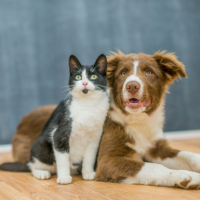Radon & Your Pets – How Does Radon Affect Them?
Radon is a hidden danger in many homes, often going unnoticed. It’s well known that it’s a health risk to humans, but the potential to harm our pets is even greater. Just as radon can affect humans, pets of all kinds can be affected by radon, too. Pets are members of the family too, and they spend a lot of time inside the house, making them more vulnerable to any dangers that lurk in your home, both visible and invisible, like radon gas.
Pets are an extension of your family, and their well-being is important as well. Pets are at more risk of getting affected by radon gas, because they’re spending more time in the house than you are. While you’re coming and going, they’re usually at the house more often than out at the dog park or pet appointments.

How Does Radon Affect Pets
Radon gas doesn’t discriminate when it comes to who it has a greater effect on; dogs and cats are just as susceptible to radon gas poisoning, with it affecting their respiratory system greatly. Radon has heavy radioactive byproducts associated with it, including polonium, lead, and bismuth. The byproducts are present in the air and can build up over time, so when your furry friend is breathing in the air around them, the radioactive byproducts will stick to the cells in your pet’s lungs.
Radon is the second leading cause of lung cancer in the US for humans, and it doesn’t stop there; your dog can develop lung cancer due to exposure as well. Your four-legged friend could end up with a malignant tumor, skin masses, and epidermal carcinomas due to radon exposure over time if it develops into cancer. However, if the cancer is caught early, there is a range of treatments, similar to a diagnosis for a human, that can help your pet.
Radon can affect cats as well, if not more than dogs. If your cat has been affected by radon, they will likely show several behavioral and health problems caused by exposure. Cats contract lung cancer, and while the causes vary, radon gas poisoning is featured prominently on the list. Again, early intervention and diagnosis are key here to protecting your pets.
What You Need to Know About Pets & Radon Exposure
There are a few factors that can contribute to your pets’ radon exposure, including proximity to radon hotspots, unsealed cracks or gaps, and time spent indoors. It’s important to keep an eye on these hotspots and your pet’s demeanor. If your pet likes to spend time in the basement, you should schedule a radon test, which is a top hotspot for radon entry.
Pets don’t show symptoms of radon poisoning until they’re already sick. Symptoms can include fever, coughing, lack of appetite, abnormal swelling, breathing troubles, vomiting, and more. If you notice these symptoms, contact your vet immediately.
Steps You Can Take To Protect Pets
Getting your home tested for radon is an essential step towards having a healthy and happy home.
The Environmental Protection Agency (EPA) recommends testing for radon at least every two years to ensure nothing has changed.
If your test results show high levels, contact Guardian Radon Mitigation to install a radon mitigation system immediately. This will help prevent further exposure and is the most effective way to reduce radon levels in your home, and the systems vent radon gas outside before it accumulates indoors. Just because you’ve installed a radon mitigation system, the work doesn’t stop there, though; you’ll want to ensure the system runs properly with regular maintenance.
Radon testing, mitigation, and attention to your home’s air quality are simple steps you can take to protect your pets — and loved ones from the dangers of radon gas. Protect your Chicagoland home from the dangers of radon and keep the air you breathe clean with Oswego, Illinois’ own Guardian Radon Mitigation.
Back To Blog






